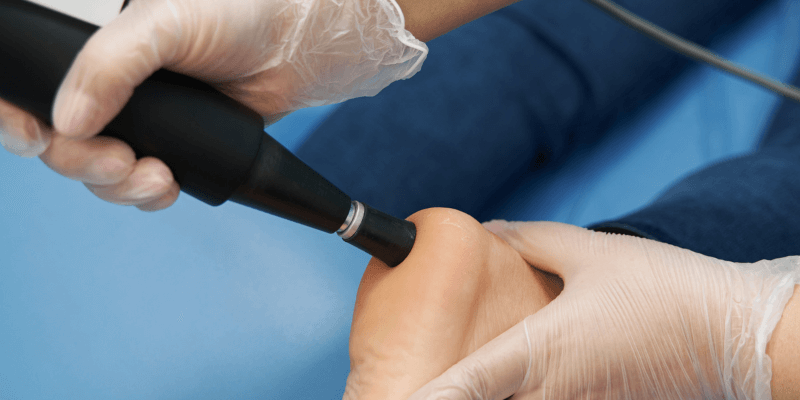Shockwave therapy for plantar fasciitis
Plantar fasciitis can be a frustrating and debilitating condition accompanied by persistent pain. But there’s hope. Shockwave therapy is a non-invasive and innovative treatment that has shown significant promise in relieving plantar fasciitis-related pain. If you’re seeking a way to regain your mobility and bid farewell to that stabbing heel discomfort, read on to discover how shockwave therapy for plantar fasciitis might be the answer you’ve been searching for.
What is Plantar Fasciitis?
Plantar fasciitis, also known as fasciopathy, is a common foot condition characterised by pain and inflammation in the plantar fascia.
The plantar fascia is a thick band of tissue that runs across the bottom of your foot, connecting your calcaneus (heel bone) to your toes. It forms the arch of the foot and acts as a shock absorber during activities like walking and running.
The primary function of the plantar fascia is to support the arch of the foot and provide stability during weight-bearing activities. It helps to distribute the body’s weight across the foot and absorbs the impact of walking, running, and other activities.
This condition often causes stabbing pain near the heel, particularly during the first steps in the morning or after periods of rest.
Plantar fasciitis pain often develops gradually over time rather than suddenly. You may not recall a specific injury or event that triggered the pain but instead notice a gradual increase in discomfort, particularly after engaging in activities that stress the foot.
What Causes Plantar Fasciitis?
Several factors contribute to the development of plantar fasciitis, including:
Age and Foot Mechanics
As we age, the plantar fascia can lose elasticity, making it more susceptible to injury. Additionally, issues with foot mechanics, such as flat feet or high arches, can contribute to strain on the plantar fascia.
Improper Footwear
Wearing shoes with inadequate support or an improper fit can increase the risk of developing plantar fasciitis.
Overuse or High-Impact Activities
Activities that involve prolonged standing, walking, or running on hard surfaces can strain the plantar fascia, leading to inflammation and pain.
Weight Gain
Excess weight puts additional stress on the plantar fascia, increasing the likelihood of developing plantar fasciitis.
Diagnosing plantar fasciitis often involves a physical examination by a healthcare professional. They may assess your medical history, and symptoms, and perform tests such as the “windlass test,” which involves dorsiflexing the toes to stretch the plantar fascia.
If you’ve tried alternative treatments for plantar fasciitis without success and are searching for a solution that truly works, your doctor may advise you to undergo a number of shockwave therapy sessions.
What Is Shockwave Therapy For Plantar Fasciitis?
Shockwave therapy, or extracorporeal shockwave therapy (ESWT), is a non-invasive and effective treatment for plantar fasciitis. This innovative approach involves using acoustic waves to stimulate healing and reduce pain in the affected area.
Extracorporeal Shockwave Therapy For Plantar Fasciitis
“Extracorporeal” means the treatment happens outside the body.
How It Works
During a shockwave therapy session, high-energy acoustic waves are directed at the heel and sole of the foot. These waves stimulate blood flow, enhance tissue repair, and reduce inflammation, promoting the natural healing process.
Painless Procedure
Shockwave therapy is generally well-tolerated and doesn’t require anesthesia. Patients may experience a tingling sensation during the procedure, but it is not typically painful.
Effectiveness
Numerous studies have shown the efficacy of shockwave therapy in treating plantar fasciitis. A study published in the Journal of Orthopaedic Research found that shockwave therapy significantly improved pain and function in patients with chronic plantar fasciitis.
The procedure is generally well-tolerated and doesn’t require anesthesia. Patients may feel a tingling sensation or mild discomfort, but it’s usually not painful.
How Many Sessions Of Shockwave Therapy For Plantar Fasciitis Do I Need?
The number of shockwave therapy sessions needed varies from person to person. Most individuals experience positive results after approximately three to five sessions.
Sessions are typically spaced a week apart to allow for optimal healing between treatments.
Patients often notice a gradual reduction in pain and improved mobility after each session. It’s essential to follow the recommended treatment plan for the best results.
Is There At-Home Shockwave Therapy For Plantar Fasciitis?
While professional shockwave therapy is conducted in a clinical setting, at-home devices are available. However, the effectiveness of these devices may vary. It’s crucial to consult with a healthcare professional before attempting any at-home treatment.
Caution: At-home devices may not provide the same level of precision and expertise as professional treatments. It’s essential to use them under the guidance of a healthcare provider, usually a podiatrist or a physiotherapist, to avoid potential risks.
In conclusion, shockwave therapy for plantar fasciitis is a promising treatment option for individuals who haven’t found relief with alternative methods.
Get in touch with our team to find out if shockwave therapy is the right choice for you and to develop a personalized treatment plan based on your specific needs.

